|

Autumn 2002 (10.3)
Pages
32-37
Art As Memory
Alakbar
Rezaguliyev's Prints of Azerbaijan
by Jean Patterson
To view other works of Alakbar Rezaguliyev, visit AZgallery.org
The
Prints of Alakbar Rezaguliyev
Life - more precisely, life under the Soviet system - was not
kind to artist Alakbar Rezaguliyev (1903-1974). During the Stalinist
repressions, Rezaguliyev was arrested three times for supposedly
spreading pan-Turkist ideas. Suffering the fate of thousands
of other intellectuals and creative geniuses, he spent the majority
of his adult life in prison and exile, nearly 25 years.
Perhaps the worst aspect of Rezaguliyev's sentence was the fact
that he was not allowed to pursue his dream of becoming an artist.
By the time he was free to return to Azerbaijan in 1956 after
Stalin had died, he was desperately out of practice, psychologically
broken and too weak even to hold a pencil.
Left: Alakbar Rezaguliyev's linoleum prints,
"Kolkhoz Collects the Wool" (1966).
Right: "Gathering Hay" (1963).
Despite the odds, Rezaguliyev worked tenaciously to develop his
talent and make a name for himself. He became well known for
his art, especially for his remarkable series of black-and-white
linoleum prints depicting scenes from turn-of-the-century Baku.
Living so long inside those prison walls left its mark on Rezaguliyev's
works - but not as one might think. Most of his prints glorify
work, although not in a way that honors this labor for the sake
of production alone. Rather, the artist invites us to appreciate
the mundane, ordinary and sheer physical process of creating
with one's own hands and mind. Many of his prints depict workers
going about their everyday chores - shoeing water buffalo, loading
hay on wagons, making flatbread (lavash) or even slitting the
bellies of sturgeon to harvest caviar.
To gain insight into Rezaguliyev's tragic life and his motivations
for creating such nostalgic images, we turned to Rezaguliyev's
youngest son, artist Aydin Rezaguliyev, and the memories of the
artist's oldest daughter, the late Adila Rezaguliyeva.
______
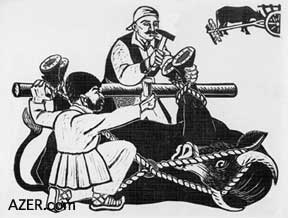  Left: Alakbar Rezaguliyev's
print "Shoeing a Water Buffalo". Left: Alakbar Rezaguliyev's
print "Shoeing a Water Buffalo".
Alakbar Rezaguliyev
was born in Baku on January 31, 1903, into the large family of
a small businessman-shopkeeper. Although there were no artists
in his family, Rezaguliyev showed artistic talent at an early
age.
"When my father was a child," Rezaguliyev's son Aydin
retells, "his grandfather spoke with the akhund [local religious
authority]: 'Our little Alakbar draws pictures. What do you recommend?'
The akhund warned: 'Don't allow him to draw. It is forbidden
by God to draw pictures of human beings; it's a sin.'"
The akhund's words fell on deaf ears. Rezaguliyev went on to
study art at the Baku Art College just after it was established;
he graduated in 1922. He then pursued his passion for art in
Moscow at the Technical Art Studios School from 1925 to 1928.
Rezaguliyev supported the Communist Party when it was first established
in Azerbaijan in the early 1920s. In fact, he was part of that
first generation of "Komsomols" in Azerbaijan. Komsomols
were high school students who were on the path to becoming full-fledged
members of the Communist Party. Such a process usually started
for children in elementary school, who became "Octobrists";
older children became "Pioneers".
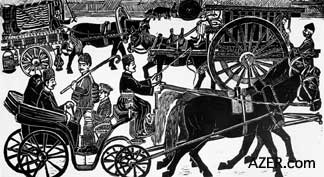  Left: Rezaguliyev's prints: Modes of transportation
in Old Baku at the turn of the 20th century. Below: "Wool
for Sale" (1963). Right: Crushing mulberries to make a thick
syrup. Left: Rezaguliyev's prints: Modes of transportation
in Old Baku at the turn of the 20th century. Below: "Wool
for Sale" (1963). Right: Crushing mulberries to make a thick
syrup.
Rezaguliyev's plan to
become a successful artist and a member of the Party was abruptly
halted in 1928. One of his friends, Ibrahim, was arrested for
spreading "pan-Turkist ideas." At that time, Stalin
and the other Soviet leaders were especially sensitive to the
possibility that Turkey could try to gain control over the Turkic
republics of the USSR. Turkic-speaking peoples lived in a wide
swath of territory along the Soviet southern flank and were united
by similar Turkic languages. These Turkic republics included
Azerbaijan, Kazakhstan, Turkmenistan, Uzbekistan and Kyrgyzstan.
Anyone who promoted unity amongst Turkey and the Turkic peoples
was targeted and accused of "pan-Turkism", an indictment
that often resulted in exile and death.
Since Rezaguliyev was associated with Ibrahim, he was arrested,
too, and sentenced to six years of exile in the freezing - cold,
sparsely inhabited region of Arkhangelsk in northwest Russia.
"I suspect that somebody falsely brought accusations against
my father," Aydin says. "After all, he was one of the
first Komsomols in Azerbaijan, he believed in the Communist system.
How could such a person turn around and curse the government?
It just didn't make sense. For sure, he was imprisoned without
any evidence."
 During his exile,
Rezaguliyev underwent an arranged marriage. His father, mother
and future During his exile,
Rezaguliyev underwent an arranged marriage. His father, mother
and future mother-in-law somehow managed to bring
his bride, Sona, to him at Arkhangelsk. Sona lived with him there
for a while, then returned to Baku and gave birth to their daughter
Adila (1936-1997). mother-in-law somehow managed to bring
his bride, Sona, to him at Arkhangelsk. Sona lived with him there
for a while, then returned to Baku and gave birth to their daughter
Adila (1936-1997).
Exiled Again
After his release and return to Baku, Rezaguliyev ran into one
of the Bolshevik leaders, Ruhullah Akhundov, who was surprised
to see him out of prison. "Hey, you dumb guy, are you back
here again?" And with those words, he was promptly arrested
again and exiled to Solovki in the icy Arctic.
Right: Women's traditional
apparel, especially in some rural areas in the 19th century (1960).
"I was six months old in November 1937, when Father was
arrested," daughter Adila recalled on a television feature
about Rezaguliyev. "I didn't see him again until 10 years
later, in 1947. At that time when we met again, we didn't recognize
each other. Then he broke down and sobbed, saying that he was
so thankful to his parents for taking care of his keepsake for
all those years."
Between 1947 and 1949, Rezaguliyev and his family lived in the
northwestern regions of Azerbaijan. "The authorities wouldn't
let him live in Baku," Adila said. "We had to live
in Ganja and Shaki. I remember that he used to prepare sketches
for the silk factory in Shaki, where there was a large silk industry
at the time. He also taught school there.
"I remember one day when I was sitting with Father and Grandpa,
a rather handsome man by the name of Bahram dropped by. He was
the producer of the Ganja Theater. He fell to his knees in front
of Father and begged him: 'Forgive me for those years, for those
words.' My father didn't say anything and just turned his head
away. Grandpa said to Father: 'Alakbar, don't you see that he's
asking for your pardon?' Father answered: 'No, Dad, I can never
forgive him. For his lie, I had to spend nearly half of my life
in exile.'"
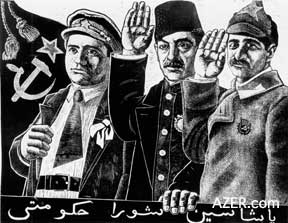  Left: "Long Live the Soviet Government"
(Azeri language in Arabic script): These three figures played
pivotal roles in the establishment of Soviet power in Azerbaijan:
Sergey Kirov (1886-1934), Nariman Narimanov (1870-1925) and Grigori
Orjonikidze (1886-1937). Ironically, under Stalin's authority,
they all became victims and were annihilated by the system they
helped to create. Left: "Long Live the Soviet Government"
(Azeri language in Arabic script): These three figures played
pivotal roles in the establishment of Soviet power in Azerbaijan:
Sergey Kirov (1886-1934), Nariman Narimanov (1870-1925) and Grigori
Orjonikidze (1886-1937). Ironically, under Stalin's authority,
they all became victims and were annihilated by the system they
helped to create.
In 1949, shortly after
his second daughter, Sevil, was born, Rezaguliyev was arrested
yet again and sent to the frigid Altai Province in northern Russia.
While in exile, he married again, this time to a German girl
named Berta, whose parents and grandparents had been living in
a German settlement in the Saratov Autonomous Region. At the
beginning of World War II, Berta's family had been sent into
exile, just like all of the other Germans who were living in
the USSR.
"I was the only one in the family who knew about Father's
second marriage," Adila confided. "He wrote me secretly
and asked me not to be angry with him for marrying again, that
he did it only to keep from dying of hunger and cold. He found
a warm home for himself by marrying that woman." Rezaguliyev
and Berta had two sons, Ogtay and Aydin, and a daughter, Sevda.
In 1956, three years after Stalin's death, Rezaguliyev was exonerated
and released from exile. Stalin's repressions were over.
By the early 1960s, Berta and her children were allowed to join
him in Azerbaijan. Aydin remembers the pressures of adjusting
to Baku and blending in with his father's existing family. "I
was in the second grade at the time, and I remember how difficult
it was for us when we came to Baku. We only knew how to speak
German - not Russian or Azeri. Slowly, things got better. We
lived in the Montin settlement, which is in the Narimanov district
of Baku."
Not surprisingly, those 25 years of exile had taken a serious
toll on Rezaguliyev's health. "When Father came back, his
hands were stiff," Adila recalled. "He had trouble
just holding a pencil."
"The exile greatly affected my father's personality,"
Aydin adds. "He became very serious. You can see it in his
photos: in the early ones, he was always smiling, but after he
was exiled - never. Being imprisoned all those years morally
broke him."
Eager to Work
Rezaguliyev threw himself into his art, working day and night
to develop his technique. "I remember my father would leave
the house each day at 7 a.m. and go to work at his studio,"
Aydin says. "He only came home for lunch for 30 minutes
and then went back to work at his studio until evening."
"Whenever I saw him, he was busy with work," Adila
remembered. "I often asked my father why he worked so much.
He would tell me, 'I want to reclaim all that time that I've
lost. Those years took all of my ideas, works and memories away
from me. That's why I have to make the most of the remaining
years of my life.'" Aydin says it was rare for his father
to work with colors after he returned from prison: "He worked
almost exclusively in black and white. Maybe he felt like he
didn't have enough time to master the use of color. Or maybe
being in an environment of stark white snow had affected his
sight, robbing him of his ability to deal with the nuances of
color."
Fellow artist Rasim Babayev (1927- ) encouraged Rezaguliyev to
work with linoleum prints because the technique was less complicated
and didn't require the use of color. Taking Babayev's advice,
Rezaguliyev went on to create numerous prints, including more
than 150 black-and-white prints depicting the Baku of his childhood.
Time and again, until the end of his life, he kept adding works
to what he called his "Old Baku" series.
"All of the ideas and memories from his heart were included
in this series," Aydin says. "Here were the old characters
that he remembered from his childhood: the 'Pomegranate Vendor,'
the 'Oil Seller' and the 'Lamplighter'. He knew them all by heart.
They are among my favorite works of my father's."
Many of Rezaguliyev's prints show people involved with daily
chores, whether it be washing carpets, lighting lamps or selling
water. One wonders if he paid so much attention to the routines
of everyday life because he himself was deprived of the chance
to be involved with such mundane activities during his nearly
25 years of exile.
Due to his hard work, Rezaguliyev managed to gain a reputation
before his death in 1974. In 1963, at age 60, he had his first
solo exhibition. In 1964, he was named Honored Art Worker. His
works were featured in museums throughout the Soviet Union, including
the Pushkin Museum, the Hermitage and the Museum of Eastern People.
Next year marks the 100th anniversary of Alakbar Rezaguliyev's
birth. A Jubilee will celebrate his creative life in the midst
of extreme hardship.
______
This article was based on several
interviews with Aydin Rezaguliyev conducted by Betty Blair, Jala
Garibova and Gulnar Aydamirova, plus the recorded interview with
the late Adila Rezaguliyeva that appeared on the television program
"Yaddash" (Memory) on AzTV.
To read more about Alakbar Rezaguliyev, see the article "Street
Scenes from Yesteryear: The Linoleum Prints of Alakbar Rezaguliyev"
in AI
8.2 (Summer 2000).
To view more than 70 of his prints, visit AZgallery.org.
Originals of his works may be found in various office buildings
throughout Baku, including the Regus offices in the Landmark
Building and the International Bank of Azerbaijan. You may visit
the Baku art studio of his son Aydin, also an artist, and see
prints created by his father by calling
(994-12) 39-44-19.
Back to Index AI 10.3 (Autumn
2002)
AI Home
| Search | Magazine
Choice
| Topics
| AI Store | Contact us
Other Web sites
created by Azerbaijan International
AZgallery.org | AZERI.org | HAJIBEYOV.com
|

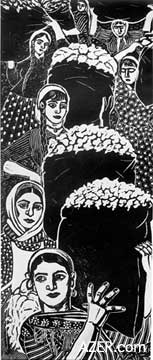
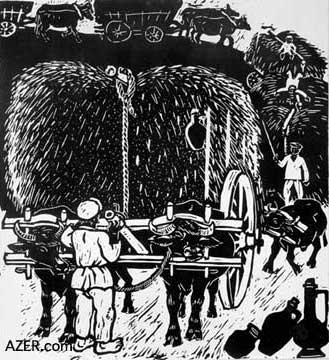


 During his exile,
Rezaguliyev underwent an arranged marriage. His father, mother
and future
During his exile,
Rezaguliyev underwent an arranged marriage. His father, mother
and future